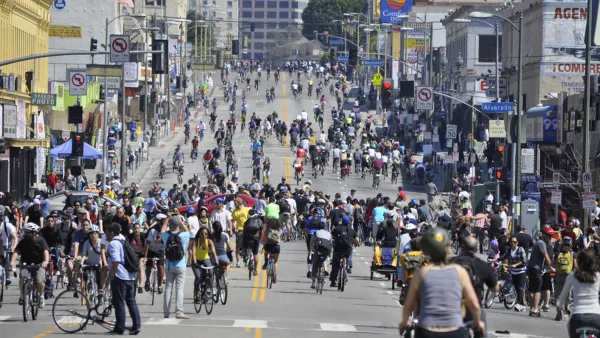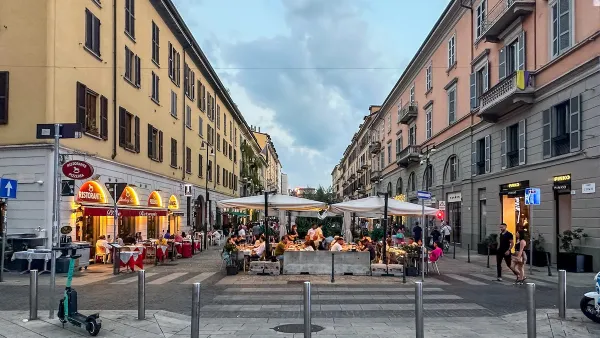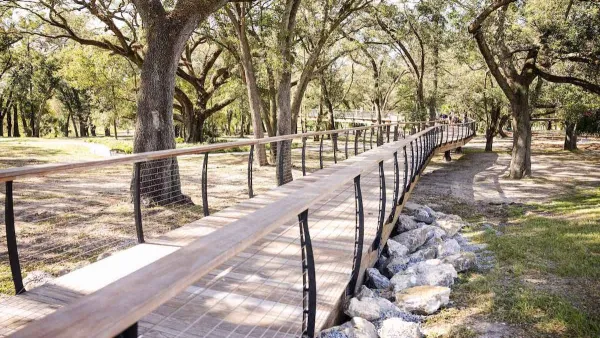An interdisciplinary team of urban designers, architects, and analysts have proposed a neo-retro-futurist scenario for making downtown Portland nearly car-free by 2050.
Portland may be taking a nod from Los Angeles' 70's-era planning history to make future development in their downtown area car-free, or almost car-free by 2050. Yesterday, the urban planning and policy blog Hugeasscity reported on a GGLO proposal to repurpose the city's historic Memorial Coliseum building, located at the perimeter of the downtown core, into a colossal automated park and ride.
In typical Portland fashion, however, there is a Green-ish twist. Instead of cementing a future of auto-dominated travel, the building will become the opening salvo in the car's ultimate retreat from the City. At first, the park and ride (called a "mobility hub") will serve as a redevelopment catalyst – freeing most new construction in the downtown core from the financial and spatial burden of providing parking, thereby enabling increased overall density and affordability. Very much like a giganto-scaled version the "Park Once" garages that supported the recent revitalization of the 3rd Street area in Santa Monica and East Colorado Boulevard in Pasadena, or a modern reinterpretation of LA City's 1970 plan that located massive parking structures on the 101, 110, 5, 10 loop around downtown. The big difference here is threefold: Portland's garage will be 500 feet from high-quality regional rapid rail and bus transit, it's 5200-car capacity would be a civic spectacle in and of itself, and it's use as a garage that facilitates auto travel would sunset. After 40 years, when urban density and vibrancy have increased to the point that cars as we know them are obsolete, the building will become a car memorial museum. With the push of a button, visitors could "order up" any one of the 5200 cars stored in the collection, and it would be delivered to their feet for viewing.
The Coliseum "mobility hub" would be one of a series, whose modular automated parking units could be disassembled or repurposed when density near the core increases, and reassembled farther out to catalyze compact development elsewhere.
The proposal is an audacious response to the 2010 Rose Quarter "Call for Concepts" and to Portland's bold 2009 Climate Action Plan, which requires an 80% reduction of GHG emissions by 2050, when population is forecast to have grown by 90%.
FULL STORY: Coolest Park and Ride Ever

National Parks Layoffs Will Cause Communities to Lose Billions
Thousands of essential park workers were laid off this week, just before the busy spring break season.

Retro-silient?: America’s First “Eco-burb,” The Woodlands Turns 50
A master-planned community north of Houston offers lessons on green infrastructure and resilient design, but falls short of its founder’s lofty affordability and walkability goals.

Delivering for America Plan Will Downgrade Mail Service in at Least 49.5 Percent of Zip Codes
Republican and Democrat lawmakers criticize the plan for its disproportionate negative impact on rural communities.

Test News Post 1
This is a summary

Test News Headline 46
Test for the image on the front page.

Balancing Bombs and Butterflies: How the National Guard Protects a Rare Species
The National Guard at Fort Indiantown Gap uses GIS technology and land management strategies to balance military training with conservation efforts, ensuring the survival of the rare eastern regal fritillary butterfly.
Urban Design for Planners 1: Software Tools
This six-course series explores essential urban design concepts using open source software and equips planners with the tools they need to participate fully in the urban design process.
Planning for Universal Design
Learn the tools for implementing Universal Design in planning regulations.
EMC Planning Group, Inc.
Planetizen
Planetizen
Mpact (formerly Rail~Volution)
Great Falls Development Authority, Inc.
HUDs Office of Policy Development and Research
NYU Wagner Graduate School of Public Service





























